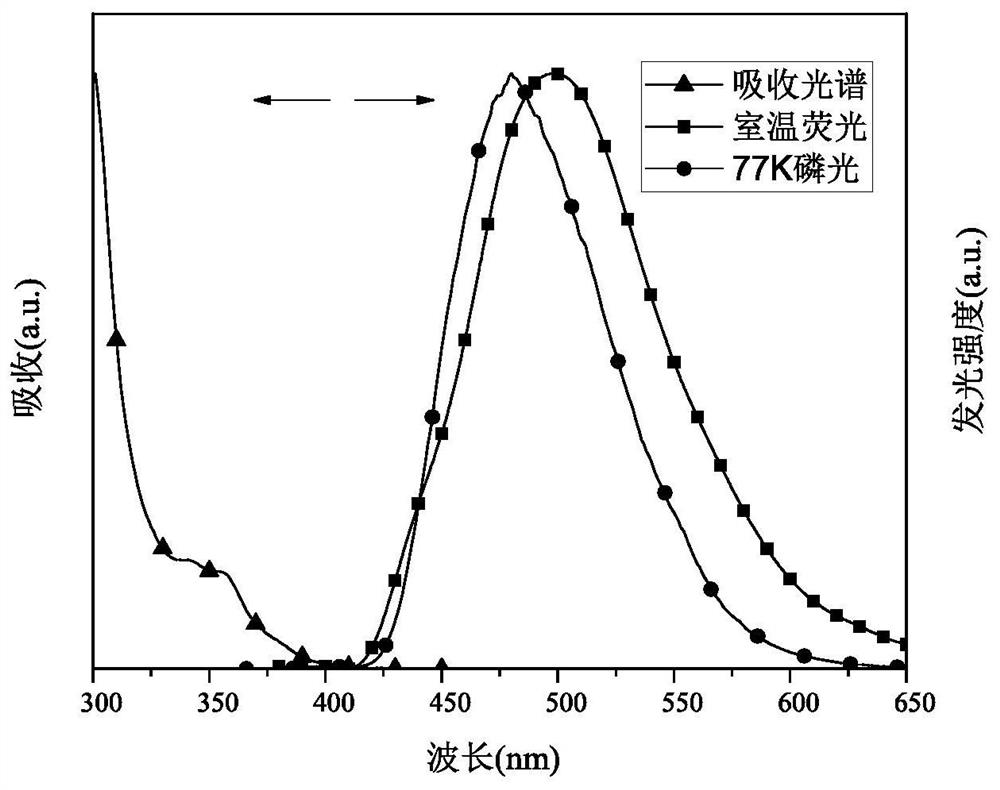A thermally induced delayed fluorescence compound and its preparation method and application
A delayed fluorescence, compound technology, applied in chemical instruments and methods, semiconductor/solid-state device manufacturing, organic chemistry, etc., can solve the problem of reducing the twist angle between donor/acceptor, molecular HOMO and LUMO cannot be effectively separated, and cannot be obtained. Good stability and high-efficiency TADF new materials, etc., to achieve the effect of high efficiency and breaking through the limit of external quantum efficiency
- Summary
- Abstract
- Description
- Claims
- Application Information
AI Technical Summary
Problems solved by technology
Method used
Image
Examples
preparation example Construction
[0074] The present invention also provides a preparation method of a heat-induced delayed fluorescence compound, comprising:
[0075] The compound having the structure of formula (II) is coupled with the compound of formula (III) to obtain the compound of structure shown in formula (I);
[0076]
[0077] Among them, R 1 , R 2 Independently selected from C1-C30 alkyl, C1-C30 alkoxy, C2-C36 dihydrocarbylamine, C6-C35 substituted aryl or C6-C35 unsubstituted aryl;
[0078] Ar is Ar 1 or Ar 2 ;
[0079] Ar 1 、Ar 2independently selected from C6~C50 substituted aryl, C6~C50 arylamine, C4~C50 substituted heteroaryl, C4~C50 substituted arylheterogroup or hydrogen, and Ar 1 、Ar 2 not simultaneously hydrogen;
[0080] A is a C6-C50 aryl group or a C3-C45 heteroaryl group containing an electron-withdrawing substituent;
[0081] x 1 、X 2 for bromine or hydrogen.
[0082] According to the present invention, the present invention couples the compound with the structure of fo...
Embodiment 1
[0100] Embodiment 1: the synthesis of compound AcPTC
[0101] The preparation process is shown in the following formula:
[0102]
[0103] The specific steps are:
[0104] 1,8-dibromo-9-(4-(4,6-diphenyl-1,3,5-triazine)phenyl)-3,6-di-tert-butylcarbazole (744mg, 1mmol), 4-(9,9'-dimethylacridin-10-yl)phenylboronic acid (1.32g, 4mmol), tris(dibenzylideneacetone)dipalladium (18mg, 0.02mmol), 2-bicyclohexylphosphine- 2',6'-dimethoxybiphenyl (32mg, 0.08mmol), potassium phosphate (1.06g, 4mmol) were added to a 50ml Schlenk bottle, tetrahydrofuran (10mL) and deoxygenated deionized water (2mL) were added, 80 ℃ reflux reaction for 24h. After the reaction, cool to room temperature, pour the reaction liquid into water, extract three times with dichloromethane, and combine the organic phases. The organic phase was washed three times with 100 ml of water, then dried over anhydrous sodium sulfate. The solution was filtered and concentrated. Separation was carried out through a silica...
Embodiment 2
[0105] Embodiment 2: the synthesis of compound PAPTC
[0106] The preparation process is shown in the following formula:
[0107]
[0108] The specific steps are:
[0109] 1,8-dibromo-9-(4-(4,6-diphenyl-1,3,5-triazine)phenyl)-3,6-di-tert-butylcarbazole (744mg, 1mmol), 4-(9,9'-dimethylacridin-10-yl)phenylboronic acid (1.16g, 4mmol), tris(dibenzylideneacetone)dipalladium (18mg, 0.02mmol), 2-bicyclohexylphosphine- 2',6'-dimethoxybiphenyl (32mg, 0.08mmol), potassium phosphate (1.06g, 4mmol) were added to a 50ml Schlenk bottle, tetrahydrofuran (10mL) and deoxygenated deionized water (2mL) were added, 80 ℃ reflux reaction for 24h. After the reaction, cool to room temperature, pour the reaction liquid into water, extract three times with dichloromethane, and combine the organic phases. The organic phase was washed three times with 100 ml of water, then dried over anhydrous sodium sulfate. The solution was filtered and concentrated. Separation was carried out through a silica...
PUM
 Login to View More
Login to View More Abstract
Description
Claims
Application Information
 Login to View More
Login to View More - R&D
- Intellectual Property
- Life Sciences
- Materials
- Tech Scout
- Unparalleled Data Quality
- Higher Quality Content
- 60% Fewer Hallucinations
Browse by: Latest US Patents, China's latest patents, Technical Efficacy Thesaurus, Application Domain, Technology Topic, Popular Technical Reports.
© 2025 PatSnap. All rights reserved.Legal|Privacy policy|Modern Slavery Act Transparency Statement|Sitemap|About US| Contact US: help@patsnap.com



